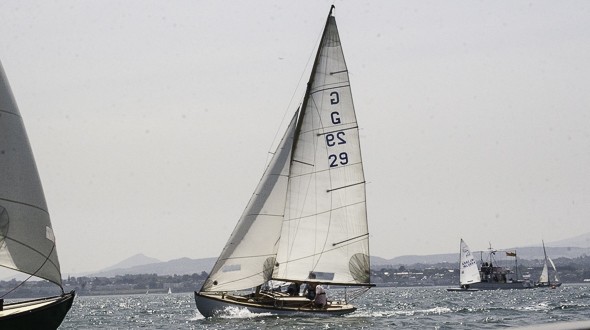Betty Armstrong’s fascinating research can be complemented by mention of a yard on the other side of Bangor. Walk past the foot of Strickland’s Glen towards Carnalea and you will clearly see the remains of a slipway. In what is now a mass of brambles and vegetation was a large shed where Arthur Clapham carried on boat-building from the 1930s till about 1960.
 During the war the yard produced the barges on which barrage balloons were mounted, and no doubt other small craft for the war effort. Immediately after the war a number of sizeable wooden vessels were built for Irish Sea fishing, among them the Davidsons, Scotts, Beatrice O’Neill and Mourne Lass. They were around 50 feet in length. But the best-known product of the yard was the class of yachts known as Glens (right), most of which are still sailing especially in Strangford Lough and from the Royal St George Yacht Club, Dun Laoghaire. These 25 foot boats were the creation of the renowned Scottish yacht designer Alfred Mylne. When Mr Clapham closed the Glen yard, he moved his operation to Whiterock, Strangford Lough.
During the war the yard produced the barges on which barrage balloons were mounted, and no doubt other small craft for the war effort. Immediately after the war a number of sizeable wooden vessels were built for Irish Sea fishing, among them the Davidsons, Scotts, Beatrice O’Neill and Mourne Lass. They were around 50 feet in length. But the best-known product of the yard was the class of yachts known as Glens (right), most of which are still sailing especially in Strangford Lough and from the Royal St George Yacht Club, Dun Laoghaire. These 25 foot boats were the creation of the renowned Scottish yacht designer Alfred Mylne. When Mr Clapham closed the Glen yard, he moved his operation to Whiterock, Strangford Lough.
One thing has puzzled me: how did the raw materials and items of equipment get to the yard? Presumably down Bryansburn Lane, but it wasn’t in my recollection much more than a narrow path on which were situated many of the small wooden holiday homes then so much a feature of the outskirts of Bangor. The Bryansglen development circa the 1970s extinguished Bryansburn Lane. (Or alternatively supplies could perhaps have come to the bottom of Downshire Road, on down the slope to the coastal path, and over the little bridge where Bryan’s burn meets the sea.)
The only trading vessel in the days of sail that I have come across built in Bangor was the schooner Mary in 1834 for Arthur Seay of the town. I wonder where she was constructed? To our eyes she would be a strange tubby craft with two masts, about 70 feet long at the most, but capable of carrying maybe 60 tons, and typical of hundreds of such vessels which were the white vans of their day ! She must have been stoutly constructed as she traded till Christmas Eve 1881 when she went ashore near Ballyquintin Point, on a voyage from Killyleagh to Maryport in Cumberland with a cargo of hay.
